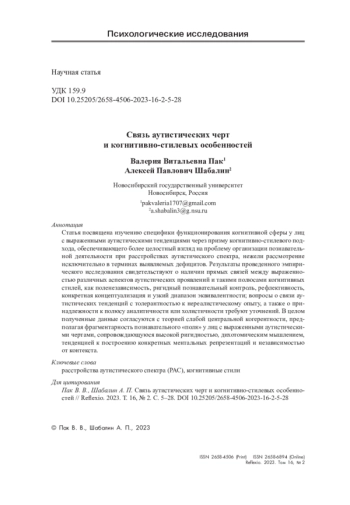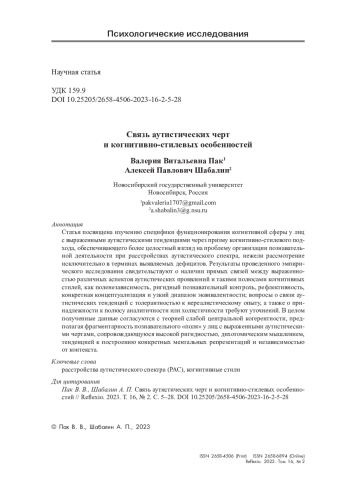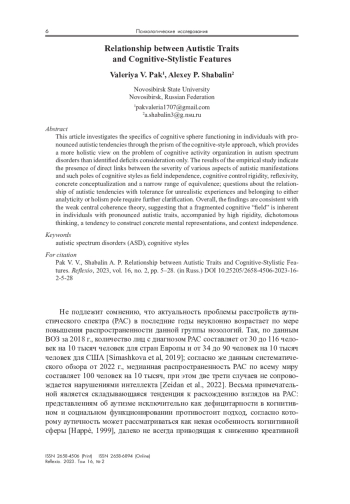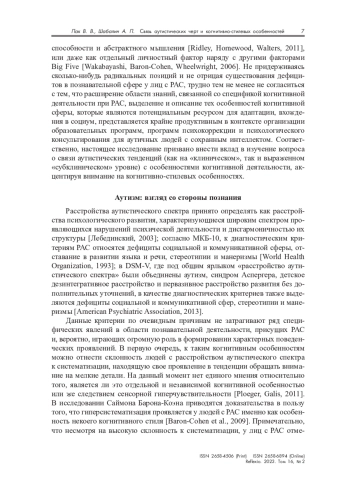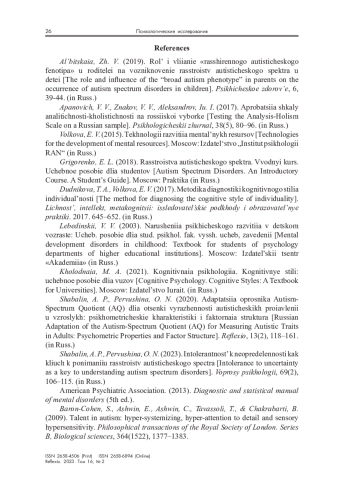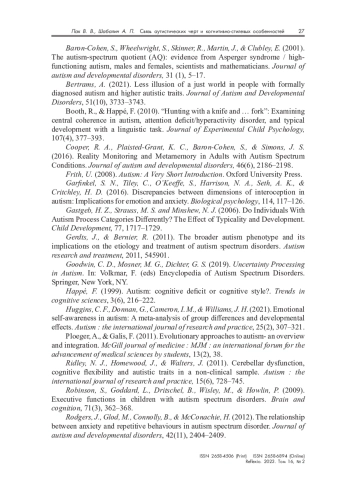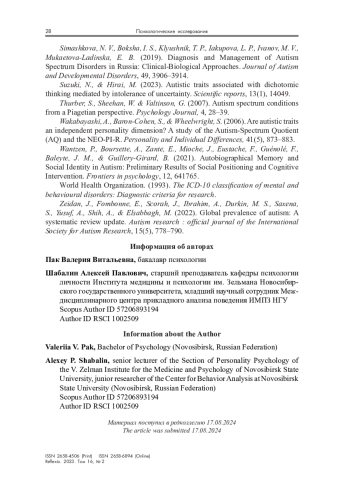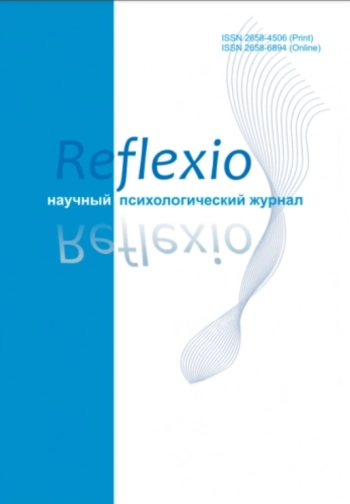Статья посвящена изучению специфики функционирования когнитивной сферы у лиц с выраженными аутистическими тенденциями через призму когнитивно-стилевого подхода, обеспечивающего более целостный взгляд на проблему организации познавательной деятельности при расстройствах аутистического спектра, нежели рассмотрение исключительно в терминах выявляемых дефицитов. Результаты проведенного эмпирического исследования свидетельствуют о наличии прямых связей между выраженностью различных аспектов аутистических проявлений и такими полюсами когнитивных стилей, как поленезависимость, ригидный познавательный контроль, рефлективность, конкретная концептуализация и узкий диапазон эквивалентности; вопросы о связи аутистических тенденций с толерантностью к нереалистическому опыту, а также о принадлежности к полюсу аналитичности или холистичности требуют уточнений. В целом полученные данные согласуются с теорией слабой центральной когерентности, предполагая фрагментарность познавательного «поля» у лиц с выраженными аутистическими чертами, сопровождающуюся высокой ригидностью, дихотомическим мышлением, тенденцией к построению конкретных ментальных репрезентаций и независимостью от контекста.
Идентификаторы и классификаторы
- Префикс DOI
- 10.25205/2658-4506-2023-16-2-5-28
Широкий фенотип РАС определяется как пограничное, «подпороговое» состояние, для которого характерно наличие особенностей в социально-коммуникативной и поведенческой сферах, аналогичных тем, что присущи аутичным людям, но выраженных в недостаточной для постановки диагноза степени [Gerdts & Bernier, 2011].
Список литературы
1. Альбицкая Ж. В. Роль и влияние «расширенного аутистического фенотипа» у родителей на возникновение расстройств аутистического спектра у детей // Психическое здоровье. 2019. № 6. С. 39-44.
2. Апанович В. В., Знаков В. В., Александров Ю. И. Апробация шкалы аналитичности-холистичности на российской выборке // Психологический журнал. 2017. Т. 38. № 5. С. 80-96.
3. Волкова Е. В. Технологии развития ментальных ресурсов. М.: Институт психологии РАН, 2015. 256 с.
4. Григоренко Е. Л. Расстройства аутистического спектра. Вводный курс: Учебное пособие для студентов. М.: Практика, 2018. 280 с.
5. Дудникова Т. А., Волкова Е. В. Методика диагностики когнитивного стиля индивидуальности // Личность, интеллект, метакогниции: исследовательские подходы и образовательные практики. 2017. С. 645-652.
6. Лебединский В. В. Нарушения психического развития в детском возрасте: Учеб. пособие для студ. психол. фак. высш. учеб. заведений. М.: Академия, 2003. 144 с.
7. Холодная М. А. Когнитивная психология. Когнитивные стили: Учебное пособие для вузов. 3-е изд. М.: Юрайт, 2021. 307 с.
8. Шабалин А. П., Первушина О. Н. Адаптация опросника Autism-Spectrum Quotient (AQ) для оценки выраженности аутистических проявлений у взрослых: психометрические характеристики и факторная структура // Reflexio. 2020. Т. 13. № 2. С. 118-161.
9. Шабалин А. П., Первушина О. Н. Интолерантность к неопределенности как ключ к пониманию расстройств аутистического спектра // Вопросы психологии. 2023. Т. 69. № 2. С. 106-115.
10. American Psychiatric Association. Diagnostic and statistical manual of mental disorders (5th ed.). Washington, D.C.: American Psychiatric Publishing, 2013.
11. Baron-Cohen S., Ashwin E., Ashwin C., Tavassoli T., & Chakrabarti B. Talent in autism: hyper-systemizing, hyper-attention to detail and sensory hypersensitivity // Philosophical transactions of the Royal Society of London. Series B, Biological sciences. 2009. Vol. 364 (1522). P. 1377-1383.
12. Baron-Cohen S., Wheelwright S., Skinner R., Martin J., & Clubley E. (2001). The autism-spectrum quotient (AQ): evidence from Asperger syndrome / highfunctioning autism, males and females, scientists and mathematicians // Journal of autism and developmental disorders. 2001. Vol. 31 (1), P. 5-17.
13. Bertrams A. Less illusion of a just world in people with formally diagnosed autism and higher autistic traits // Journal of Autism and Developmental Disorders. 2021. Vol. 51 (10). P. 3733-3743.
14. Booth R. & Happé F. “Hunting with a knife and … fork”: Examining central coherence in autism, attention deficit/hyperactivity disorder, and typical development with a linguistic task // Journal of Experimental Child Psychology. 2010. Vol. 107 (4) P. 377-393.
15. Cooper R. A., Plaisted-Grant K. C., Baron-Cohen S. & Simons J. S. Reality Monitoring and Metamemory in Adults with Autism Spectrum Conditions // Journal of autism and developmental disorders. 2016. Vol. 46 (6). P. 2186-2198.
16. Frith U. Autism: A Very Short Introduction. Oxford: Oxford University Press, 2008.
17. Garfinkel S. N., Tiley C., O’Keeffe S., Harrison N. A., Seth A. K., & Critchley H. D. // Discrepancies between dimensions of interoception in autism: Implications for emotion and anxiety. Biological psychology. 2016. Vol. 114. P. 117-126.
18. Gastgeb H. Z., Strauss M. S., Minshew N. J. Do Individuals With Autism Process Categories Differently? The Effect of Typicality and Development // Child Development. 2006. Vol. 77. P. 1717-1729.
19. Gerdts J. & Bernier R. The broader autism phenotype and its implications on the etiology and treatment of autism spectrum disorders // Autism research and treatment. 2011. 545901.
20. Goodwin C. D., Mosner M. G., Dichter G. S. Uncertainty Processing in Autism. In: Volkmar, F. (eds) Encyclopedia of Autism Spectrum Disorders. New York: Springer, 2019.
21. Happé F. Autism: cognitive deficit or cognitive style? // Trends in cognitive sciences. 1999. Vol. 3 (6). P. 216-222.
22. Huggins C. F., Donnan G., Cameron I. M., & Williams J. H. Emotional selfawareness in autism: A meta-analysis of group differences and developmental effects// Autism : the international journal of research and practice. 2021. Vol. 25 (2). P. 307-321.
23. Ploeger A. & Galis F. Evolutionary approaches to autism- an overview and integration // McGill journal of medicine : MJM : an international forum for the advancement of medical sciences by students. 2011. Vol. 13 (2). P. 38.
24. Ridley N. J., Homewood J. & Walters J. Cerebellar dysfunction, cognitive flexibility and autistic traits in a non-clinical sample // Autism : the international journal of research and practice. 2011. Vol. 15 (6). P. 728-745.
25. Robinson S., Goddard L., Dritschel B., Wisley M. & Howlin P. (2009). Executive functions in children with autism spectrum disorders // Brain and cognition. 2009. Vol. 71 (3). P. 362-368.
26. Rodgers J., Glod M., Connolly B., & McConachie H. The relationship between anxiety and repetitive behaviours in autism spectrum disorder // Journal of autism and developmental disorders. 2012. Vol. 42 (11). P. 2404-2409.
27. Simashkova N. V., Boksha I. S., Klyushnik T. P., Iakupova L. P., Ivanov M. V., Mukaetova-Ladinska E. B. Diagnosis and Management of Autism Spectrum Disorders in Russia: Clinical-Biological Approaches // Journal of Autism and Developmental Disorders. 2019. Vol. 49. P. 3906-3914.
28. Suzuki N. & Hirai M. Autistic traits associated with dichotomic thinking mediated by intolerance of uncertainty // Scientific reports. 2023. Vol. 13 (1). 14049.
29. Thurber S., Sheehan W. & Valtinson G. (2007). Autism spectrum conditions from a Piagetian perspective // Psychology Journal. 2007. Vol. 4. P. 28-39.
30. Wakabayashi A., Baron-Cohen S. & Wheelwright S. Are autistic traits an independent personality dimension? A study of the Autism-Spectrum Quotient (AQ) and the NEO-PI-R // Personality and Individual Differences. 2006. Vol. 41 (5). P. 873-883.
31. Wantzen P., Boursette A., Zante E., Mioche J., Eustache F., Guénolé F., Baleyte J. M. & Guillery-Girard B. Autobiographical Memory and Social Identity in Autism: Preliminary Results of Social Positioning and Cognitive Intervention // Frontiers in psychology. 2021. Vol. 12. 641765.
32. World Health Organization. The ICD-10 classification of mental and behavioural disorders: Diagnostic criteria for research. Geneva: World Health Organization, 1993.
33. Zeidan J., Fombonne E., Scorah J., Ibrahim A., Durkin M. S., Saxena S., Yusuf A., Shih A., & Elsabbagh M. Global prevalence of autism: A systematic review update // Autism research : official journal of the International Society for Autism Research. 2022. Vol. 15 (5). P. 778-790.
Выпуск
Другие статьи выпуска
Статья посвящена анализу психометрических характеристик шкалы конформности Mehrabian и Stelf (1995). На сегодняшний день на русском языке отсутствуют методики, которые позволяли бы оценивать степень конформности. Одной из таких методик, позволяющих оценивать степень конформности, является шкала, разработанная Mehrabian и Stelf (1995). Конформность они определяют как готовность идентифицировать себя с другими и подражать им, уступать другим, чтобы избежать конфликта, быть скорее последователем, а не лидером с точки зрения идей, ценностей и поведения. В нашем исследовании приняли участие 287 человек в возрасте от 18 до 55 лет (72 мужчины и 215 женщин), из них 30 человек приняли участие в дополнительном исследовании, направленном на оценку ретестовой надежности. Было показано, что русскоязычная версия шкалы конформности Mehrabian и Stelf обладает конвергентной и дискриминантной валидностью, удовлетворительной надежностью по внутренней согласованности, но слабой ретестовой надежностью. В результате анализа внутренней структуры шкалы было показано, что однофакторная модель, предложенная авторами методики, демонстрирует хорошее соответствие данным. Двухфакторная модель, в которой прямые и обратные пункты нагружены на разные факторы, продемонстрировала отличное соответствие данным. Такой результат, однако, может быть связан с самой формулировкой прямых и обратных пунктов, а не с природой исследуемого конструкта. Сравнение групп мужчин и женщин по показателю конформности не выявило различий, что свидетельствует в пользу универсальной природы данного феномена. Дальнейшие направления исследований могут включать анализ других видов валидности, а также быть направлены на улучшение ретестовой надежности.
В статье рассматриваются особенности применения схема-терапии при лечении депрессивных расстройств. Схема-терапия является одним из направлений «третьей волны» когнитивно-поведенческой терапии, демонстрирующим значительную эффективность в лечении хронических аффективных расстройств, включая депрессию. Систематический обзор литературы позволяет осветить теоретическую базу схема-терапии, включая понятия ранних дезадаптивных схем и режимов, а также методы работы с ними для устранения симптомов депрессии. В статье синтезированы данные о эффективности схема-терапии в уменьшении проявлений депрессии, улучшении эмоциональной регуляции и повышении устойчивости лиц, страдающих этим заболеванием. Также описаны потенциальные преимущества и ограничения данного метода. В заключении изложены практические аспекты применения схема-терапии, подходящие категории пациентов и перспективы будущих исследований в контексте повышения ее эффективности и адаптации в клинической практик.
Работа посвящена исследованию взаимосвязи между уровнем развития способностей к познанию, управлению эмоциями и особенностями субъективного восприятия событий. В исследовании принимали участие 80 человек (46 женщин и 34 мужчины). Для сбора эмпирического материала были использованы: Шкала эмоционального отклика, дифференциальная анкета атрибутивных измерений, краткий опросник оптимистического атрибутивного стиля, тест социального интеллекта, опросник эмоционального интеллекта. Для обработки данных был использован корреляционный анализ. Была выявлена значимая положительная связь между оптимистическим атрибутивным стилем и некоторыми аспектами эмоционального интеллекта, в то время как ожидаемые связи с социальным интеллектом обнаружены не были.
В статье поднимается проблема развития пространственного мышления у школьников на уроках технологии. Актуальность подчеркивается важностью внедрения в учебный процесс методов и технологий объемного моделирования, способствующих активному развитию пространственного мышления учащихся. Развитию пространственного мышления способствуют разнообразные виды и техники работы с различными материалами и информационными технологиями. Лепка, моделирование, конструирование, объемные композиции из различных художественных материалов, используемые на уроках технологии в общеобразовательной школе, способствуют более эффективному формированию пространственного мышлении, воображения. Поставленная в статье проблема решает важную стратегическую задачу в образовательном процессе.
В статье дается психолого-педагогическое обоснование формирования цветового восприятия у школьников на уроках изобразительного искусства в общеобразовательной школе. Обосновывается необходимость создания объективных условий для формирования основ цветового восприятия в процессе занятий живописью с учениками младших, средних и старших классов. В статье подчеркивается особая актуальность осмысления проблемы мотивации детей в освоении цветоведения, колористики, характеристики и качества цвета. Рассматриваются упражнения и задания как теоретического характера, так и практическое решение задач формирования цветовосприятия у обучающихся. Методические рекомендации, представленные в статье, позволяют обеспечить эффективное формирование живописных качеств у школьников. Очевидно, что поставленная в статье проблема помогает учителям изобразительного искусства решать проблему в представленном ключе.
Статья посвящена проблематике изучения компонентов внутренней речи и их популяционного разнообразия. Также рассматривается представленность визуальных образов в контексте мыслительной активности человека. На выборке, включившей 694 респондента, показан удовлетворительный уровень психометрических характеристик разработанного нами опросника мыслительного потока. Результаты исследования указывают на широкую индивидуальную вариативность изученных компонентов внутренней речи (повествования и споры, обращения к себе, к вымышленному собеседнику или к репрезентации знакомого человека, наличие ответов от воображаемого собеседника, усиление разных компонентов внутренних диалогов и монологов в стрессе) и частоты и яркости внутренних визуальных образов.
Статистика статьи
Статистика просмотров за 2025 год.
Издательство
- Издательство
- НГУ
- Регион
- Россия, Новосибирск
- Почтовый адрес
- 630090, Новосибирская область, г. Новосибирск, ул. Пирогова, д. 1.
- Юр. адрес
- 630090, Новосибирская область, г. Новосибирск, ул. Пирогова, д. 1.
- ФИО
- Федорук Михаил Петрович (Руководитель)
- E-mail адрес
- rector@nsu.ru
- Контактный телефон
- +7 (383) 3634000
- Сайт
- https://www.nsu.ru/
